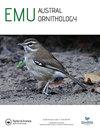利用GPS跟踪技术,揭示了布洛加(Antigone rubicunda)在一定范围内的局部迁移
IF 1.1
4区 生物学
Q3 ORNITHOLOGY
引用次数: 0
摘要
尽管人们认为该物种在繁殖区和非繁殖区之间进行季节性迁徙,并将其描述为非迁徙和部分迁徙,但目前还没有关于其迁徙模式的定量信息。我们需要了解该物种的运动行为,以了解其基本生态,并为其范围内的保护管理提供信息。因此,我们试图调查澳大利亚南部的布罗加斯是否进行季节性运动,确定个体旅行的路线,并澄清物种的迁徙状态。在这里,我们第一次量化了这个物种在繁殖区和非繁殖区之间移动的距离、时间,以及移动模式的个体水平差异。我们在澳大利亚维多利亚州的5只成年、6只幼鸟和12只6-9周大的雏鸟身上安装了GPS发射机。个体监测71 ~ 646天。这些布洛加表现出部分迁移行为,维多利亚州西南部的布洛加种群包括常住个体和迁移个体,在繁殖区和非繁殖区之间分别移动6-30公里和96-111公里,其中一些全年都留在居住地。全年平均从栖息地到觅食区移动1.6公里,大多数(95%)移动在5.2公里以内,总体而言,在非繁殖季节,布罗加移动的距离最短。我们讨论了这些运动模式的主要潜在驱动因素。这些发现可能有助于当地的保护规划,并增加我们对澳大利亚水鸟运动的更广泛的了解。本文章由计算机程序翻译,如有差异,请以英文原文为准。
Partial migration of Brolgas (Antigone rubicunda) within a restricted range is revealed by GPS tracking
ABSTRACT No quantitative information exists on the movement patterns of Brolga, Antigone rubicunda (Gruidae) although the species is considered to undertake seasonal movements between breeding and non-breeding areas, and has been also described as both non-migratory and partly migratory. Information on this species’ movement behaviour is required to understand its basic ecology and inform conservation management across its range. Thus, we sought to investigate whether Brolgas in southern Australia undertake seasonal movements, to define routes travelled by individuals, and to clarify the species’ migratory status. Here, for the first time for this species, we quantified the distances travelled, timing of movements between breeding and non-breeding areas, and individual-level differences in movement patterns. We deployed GPS transmitters on five adults, six juvenile and 12 unfledged 6–9 week chicks in Victoria, Australia. Individuals were monitored for 71–646 days. These Brolgas showed partial migratory behaviour, with the south-west Victorian population including resident and migrating individuals, moving 6–30 km and 96–111 km between breeding and non-breeding areas respectively and some remaining resident throughout the year. Brolgas moved 1.6 km from roost to foraging areas on average throughout the year, the majority (95%) of these movements were within 5.2 km and overall Brolgas moved shortest distances during the non-breeding season. We discuss the main potential drivers for these movement patterns. These findings may assist local conservation planning and add to our understanding of Australian waterbird movements more broadly.
求助全文
通过发布文献求助,成功后即可免费获取论文全文。
去求助
来源期刊

Emu-Austral Ornithology
生物-鸟类学
CiteScore
2.00
自引率
7.70%
发文量
33
审稿时长
>12 weeks
期刊介绍:
Emu – Austral Ornithology is the premier journal for ornithological research and reviews related to the Southern Hemisphere and adjacent tropics. The journal has a long and proud tradition of publishing articles on many aspects of the biology of birds, particularly their conservation and management.
 求助内容:
求助内容: 应助结果提醒方式:
应助结果提醒方式:


